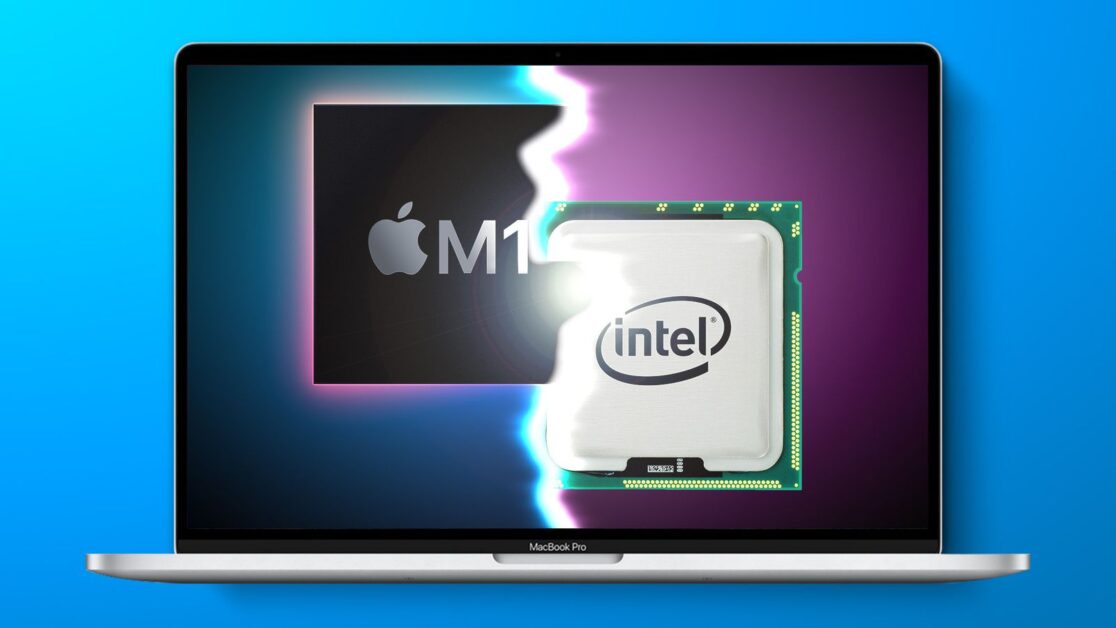Apple completely transitioned from Intel processors to Apple Silicon chips in 2022. This means that the components of the blue team will no longer be equipped with the Mac.
Thinking about the future and even if support is guaranteed for years to come, it is complicated to recommend a MacBook with Intel, even used. The decision has its pores, understand what goes into this balance.
The transition from Intel processors to Apple Silicon

Apple had its entire line of Macs equipped with its own System-on-a-Chip (SoC) by mid-2022. The transition began in late 2020, with the new MacBook Pro and Air and Mac mini. In April 2021, the colourful iMac also came up with an M1 chip.
Apple’s history with Intel began in 2005 and lasted 15 years at the company. The move comes to meet Apple’s expectations for performance and energy efficiency and further integrate software and hardware, as it already does on the iPhone and iPad.
Disregarding performance
If the goal of the purchase is performance, tests already prove the superior performance of Macs with M1 compared to those equipped with Intel.
However, anyone looking for a used MacBook probably thinks of the cost-effectiveness of using macOS and the apps available in that ecosystem, whether from third parties or Apple.
Is a MacBook with Intel still worth it?
Depends. It is necessary to understand what the pros and cons are, considering all the expectations when buying a used product. Some topics can help clarify this decision.
1. Macs support with Intel
Macs with Intel are still updated to the new versions of macOS. In the 12th version, Monterey, only MacBook Pro and Air models from 2015 onwards will receive the update. In Big Sur, the previous version, the 2013 handsets were still compatible.

Apple says the following:
Apple will continue to support and release new versions of macOS for Mac computers with Intel chip in the coming years and has more news still under development with Intel
The 2020 announcement does not specify a deadline for end-to-date support for Macs with Intel. However, these models with Intel have already ceased to receive some interesting news from macOS Monterey, the 2021 update of the operating system.
The truth is that every product has an expiration date, even the new M1. But with Apple in control, greater longevity is expected for Macs with Apple Silicon, just as the iPhone 6s still received the iOS 15, six years after launch.
Also in 2021, with macOS Monterey, Mac Pro 2013 and Mac Mini 2014 had access to the update. Nothing is guaranteed for 2024, when old machines may not pass the cutting test, yet it is a good time to live.
The conclusion of this topic is: New Macs can still be enjoyed longer. That’s obvious. If the user doesn’t mind not receiving news from macOS every year (and depending on the model’s release year) the purchase may still be worth it—which brings us to the next topic.
2. Price
Like every Apple product, Mac devaluation occurs slowly. The latest MacBook Pro and Air models with Intel announced in early 2020, can be found* at similar prices or even higher than those with M1 from the end of 2020.
In cases like this, when the release range is shorter, it may be smarter to invest in some models with M1. Otherwise, if the idea is to take something from the surroundings of 2015, it is good to consider a very good offer to close the purchase, thinking that the updates of 2024 or 2025 may not arrive for these models.
* Consider research done on June 14, 2021.
3. Application compatibility
Those who suffer at the beginning of this transition are professional consumers, who need specific software that has not yet been compiled for Apple Silicon.
But it’s all a matter of time, some programs work very well with the translation done by Rosetta 2, even if not yet compiled especially for an Apple Silicon. Since Apple chips are the future of the company’s computers, developers will also prepare their applications for this architecture.
The tip is to research whether the specific software you use works well on Macs with M1 before buying. If the answer is no and the exchange can’t wait, a Mac with Intel is the only way out—if you’re keen to continue in that Apple ecosystem.
What do I lose when Choosing a Mac with Intel?
Let’s say you found an excellent offer to buy a MacBook with used Intel that is not at the age limit, works well and will serve the purposes of the acquisition, what really gets out of the package?
At first, I would say the performance, but not every consumer takes advantage of the full potential of the Mac, so some with Intel still serve well in the performance.
The highlight of this equation is regarding new features and software updates. Even the 2020 models with Intel ran out of news from macOS Monterey and some from macOS Big Sur, such as the iOS apps available on macOS. It’s a year or a few months apart, but with an internal component that changes the game. This discrepancy tends to be more intense over time.
The same performance argument is valid for future updates: classifying the purchase as valid or will not depend on end use. A user who only wants to attend classes online or do school work, for example, sometimes doesn’t even think about updating the system—no matter how much the notification is bothering on the screen.

